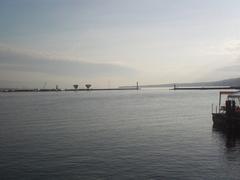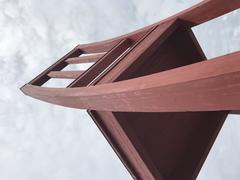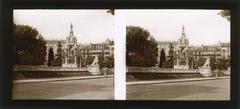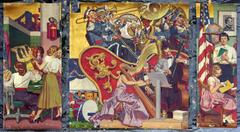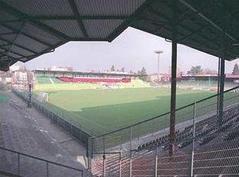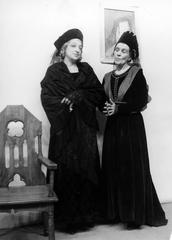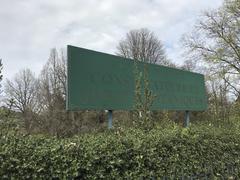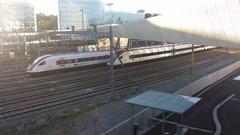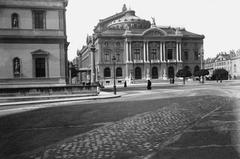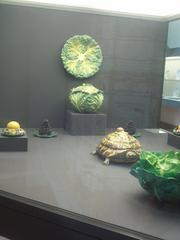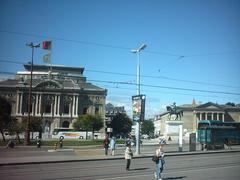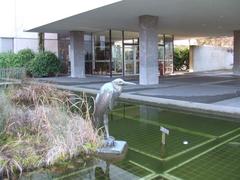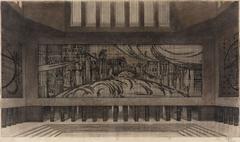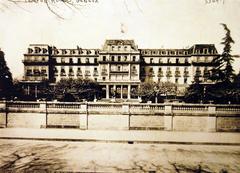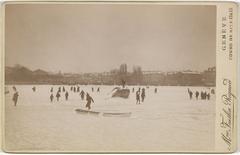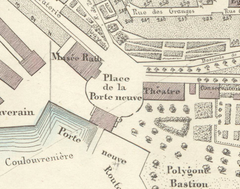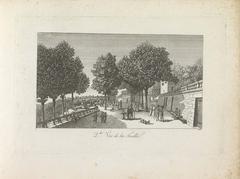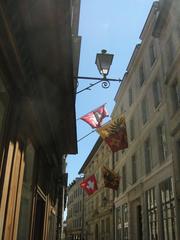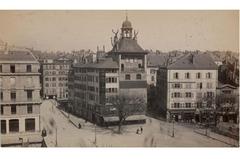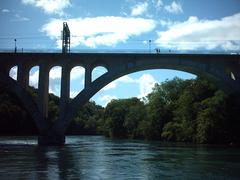Tour de Champel Visiting Hours, Tickets, and Historical Sites in Geneva
Published Date: 01/08/2024
Introduction: Discover the Charm and History of Tour de Champel
Nestled in the heart of Geneva, Switzerland, the Tour de Champel stands as a fascinating monument that offers a glimpse into the city’s rich historical and cultural heritage. This neo-gothic tower, constructed between 1877 and 1878 under the direction of David Moriaud, is a testament to Geneva’s medieval origins and its role during the Protestant Reformation. The Tour de Champel, strategically located on Champel hill, served as a lookout point and defensive structure, crucial for the city’s protection during the late Middle Ages (source). Today, it is a popular tourist destination, drawing visitors interested in medieval architecture and the history of the Reformation. This comprehensive guide will delve into the history of the Tour de Champel, provide practical visitor information, and share travel tips to ensure a memorable visit.
Table of Contents
- Introduction
- Origins and Early History
- Architectural Significance
- Role During the Reformation
- The Execution of Michael Servetus
- 19th and 20th Century Developments
- Modern-Day Significance
- Visitor Information
- Travel Tips
- Preservation Efforts
- FAQ
- Conclusion
Origins and Early History
The Tour de Champel, located in Geneva, Switzerland, is a historical tower with roots tracing back to the 15th century. Originally constructed in 1470, the tower served as a strategic lookout point and a defensive structure. Its primary purpose was to monitor the surrounding area for any potential threats, particularly during the turbulent times of the late Middle Ages. The tower’s location on Champel hill provided a vantage point that was crucial for the defense of Geneva.
Architectural Significance
The Tour de Champel is an exemplary model of medieval military architecture. The tower is constructed primarily from local stone, which was a common building material in the region during the 15th century. The structure features a cylindrical design, which was typical for defensive towers of that era. This design not only provided a robust defense against attacks but also allowed for a panoramic view of the surrounding landscape.
Role During the Reformation
The 16th century was a period of significant religious and political upheaval in Europe, and Geneva was no exception. The Tour de Champel played a notable role during the Protestant Reformation. Geneva became a center for Protestant reformers, and the tower was used as a lookout point to guard against Catholic forces. The tower’s strategic importance was highlighted during this period, as it helped protect the city from external threats.
The Execution of Michael Servetus
One of the most infamous events associated with the Tour de Champel is the execution of Michael Servetus in 1553. Servetus was a Spanish physician and theologian who was condemned for heresy by both the Catholic Church and the Protestant reformers. After being arrested in Geneva, he was imprisoned in the Tour de Champel before being burned at the stake on Champel hill. This event is a significant historical moment, reflecting the intense religious conflicts of the time. More details about this event can be found here.
19th and 20th Century Developments
In the 19th century, the Tour de Champel underwent several renovations to preserve its historical integrity. The tower was recognized as a cultural heritage site, and efforts were made to maintain its structure. During this period, the surrounding area of Champel also began to develop, transforming from a rural landscape into a more urbanized district.
The 20th century saw further preservation efforts, particularly after World War II. The tower became a symbol of Geneva’s rich historical past, and it was incorporated into various cultural and educational programs. The local government and historical societies have worked diligently to ensure that the Tour de Champel remains a well-preserved monument.
Modern-Day Significance
Today, the Tour de Champel stands as a testament to Geneva’s historical and cultural heritage. It is a popular tourist attraction, drawing visitors from around the world who are interested in medieval architecture and the history of the Reformation. The tower is also used for educational purposes, with guided tours and informational plaques that provide insights into its historical significance.
The surrounding area of Champel has become a vibrant neighborhood, blending historical landmarks with modern amenities. Visitors can explore the tower and then enjoy the nearby parks, cafes, and shops. The Tour de Champel is not only a historical monument but also a part of the living history of Geneva.
Visitor Information
For those planning to visit the Tour de Champel, it is important to check the opening hours and any special events that might be taking place. The tower is accessible to the public, and guided tours are available for those interested in a more in-depth exploration of its history. More visitor information can be found here.
Ticket Prices: Entry to the Tour de Champel is free, but donations are appreciated to support ongoing preservation efforts.
Opening Hours: The tower is open daily from 10 AM to 6 PM. Special events and tours may have different timings, so it’s advisable to check in advance.
Accessibility: The Tour de Champel is partially accessible to people with disabilities. The ground floor is wheelchair accessible, but the upper levels may pose challenges for those with mobility issues.
Travel Tips
How to Get There: The Tour de Champel is easily accessible via public transportation. Visitors can take tram line 12 or bus line 1 to the Champel stop, which is a short walk from the tower.
Best Times to Visit: The best time to visit the Tour de Champel is during the spring and autumn months when the weather is pleasant, and the surrounding parks are in full bloom.
Nearby Attractions: While in Champel, visitors can explore nearby attractions such as Parc Bertrand, the Museum of Natural History, and the Geneva Botanical Garden. These sites offer a well-rounded experience of Geneva’s natural and cultural beauty.
Preservation Efforts
Preservation of the Tour de Champel is an ongoing effort. The local government, along with various historical and cultural organizations, continues to invest in the maintenance and restoration of the tower. These efforts ensure that the tower remains a significant historical site for future generations. Information about current preservation projects can be found here.
FAQ
Is the Tour de Champel open to the public?
Yes, the Tour de Champel is open to the public daily from 10 AM to 6 PM.
What are the best times to visit the Tour de Champel?
The best times to visit are during the spring and autumn months when the weather is pleasant.
Is there an admission fee for the Tour de Champel?
No, entry to the tower is free, but donations are appreciated.
Is the Tour de Champel accessible to people with disabilities?
The ground floor is wheelchair accessible, but the upper levels may pose challenges.
Conclusion: Key Takeaways from Your Visit to Tour de Champel
The Tour de Champel is more than just a historical monument; it is a symbol of Geneva’s rich cultural and historical tapestry. From its origins as a 15th-century defensive structure to its role during the Protestant Reformation and its preservation into the modern era, the tower offers a unique glimpse into the city’s past. Visitors can explore its fascinating history, enjoy the surrounding parks, and immerse themselves in Geneva’s vibrant cultural scene. Whether you are a history enthusiast or a casual tourist, the Tour de Champel provides a captivating and educational experience that should not be missed. Stay updated with the latest information and events by visiting the official Geneva tourism website and consider supporting the ongoing preservation efforts through donations.


